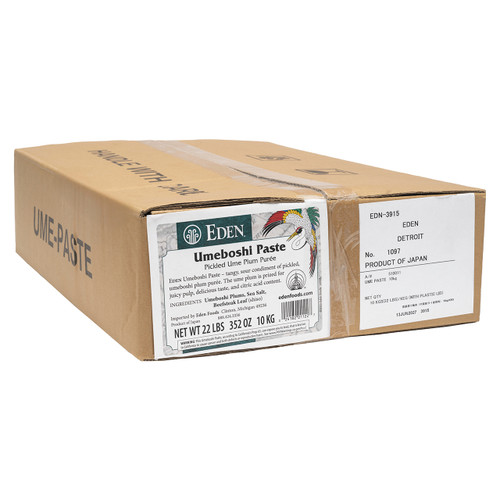Pickled, sun-dried, infused with red shiso (beefsteak) leaves, and aged for a year. Ideal for sushi and rice balls, they lend tartness to dressings, dips, and sauces. Japan's chicken soup in cold and flu season is okayu, a thin rice porridge with umeboshi. Made of the 'nanko' plum variety that is prized for its juicy pulp, delicious flavor, and high citric acid content. 'The king of alkaline foods', umeboshi plums are an ancient food used to balance and strengthen. Traditionally valued as a digestive aid.
MORE DETAILS
Eden Umeboshi Plums are made from unripe green plums Prunus mume, harvested toward the end of June when their juice is the most acidic. The plums are first washed and soaked overnight to remove bitterness, before placing them in large kegs with alternating layers of sea salt. The salt immediately begins to draw juice from the plums. To keep the plums submerged in the juice, a flat lid weighted with stones is place on the top. The combination of salt and pressure extracts the juice creating the pickle brine. The plums are kept in this salty, dark, unheated environment for one month. Desirable lactic acid bacteria quickly multiply under these conditions inhibiting the growth of undesirable microorganisms and enzymes. The plums are then removed, placed on wooden racks and left outside to sun dry for four to seven days depending upon the weather. Red shiso leaves are placed in the brine turning it a brilliant red. The sun dried plums are replaced in this red brine where they soak for four or five more days. Their color changes from green to pinkish-red. The plums are removed from the salty red brine and placed in kegs where they are allowed to naturally age for a year or more. It is said that an umeboshi aged five years has had all of its citric acid move from the flesh of the plum into its pit and back into the flesh, transformed and energized. The red pickling brine is bottled and sold as tangy, salty umeboshi vinegar.
The plums used to make umeboshi are actually an Asian variety of apricot Prunus mume that has been referred to as a plum for centuries. The first reference to umeboshi was recorded in the 10th century in Japan, although they are believed to have originated in China over 2,000 years ago. Shiso Perilla frutescens, a member of the mint family, is a small bush with dark red or green heart shaped leaves. The red leaves, known as 'beefsteak' leaves, are used. Besides adding color to the umeboshi, red shiso contains a natural preservative called 'perilla-aldehyde,' that is documented to have over one thousand times the strength of synthetic preservatives used in food., and when ingested contributes to digestive health.
Umeboshi plums are valued as an alkalizer, a digestive aid, and an appetite stimulant. Umeboshi is believed to help maintain a healthy acid/alkaline balance.
Unlike most commercial umeboshi plums, Eden Umeboshi Plums are made in the ancient and traditional manner used for over 2,000 years. They contain no artificial red coloring agents, preservatives or flavorings.
Eden Umeboshi Plums impart a delicious tangy, salty flavor to sauces, salad dressings, dips, and vegetable dishes. Great in nori rolls, rice balls or with grains. For a special treat rub just a little on corn on the cob in place of butter.














